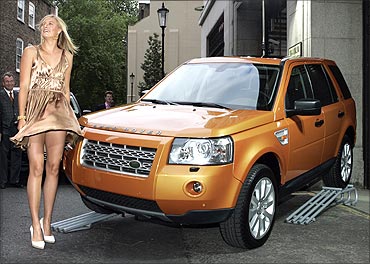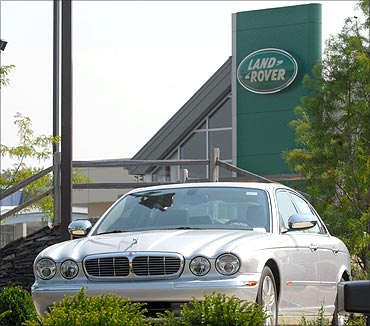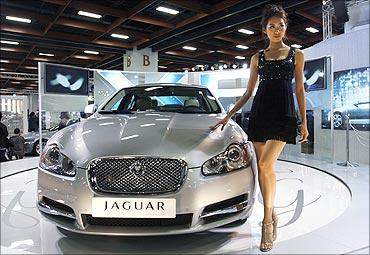Photographs: Reuters
Though the Tata Motors' stock has corrected 12 per cent (in line with the markets) since end-December due to domestic macroeconomic headwinds, the company continues to impress with strong financials.
The latter is backed by rising sales of its UK-based subsidiary Jaguar Land Rover, steady commercial vehicle numbers and strong cash flows.
Thanks to the turnaround in JLR's performance, the stock has been the best performer in the large cap auto segment, with returns of 65 per cent since January 2010 compared to BSE Auto's 22 per cent and a measly 8.36 per cent for the Sensex.
While the overall demand has been steady so far, the company is facing tough challenges on account of stiff competition in the domestic passenger vehicles segment and rising raw material costs at the operational level.
Tata Motors on JLR cruise
Image: JLR's sales were driven by Chinese demandPhotographs: Reuters
Strong CV, JLR performance
On the back of good volumes in the December quarter from the domestic CV segment (up 21 per cent year-on-year) and those of JLR (up 6 per cent), Tata Motors recorded a 22 per cent growth in its consolidated sales to Rs. 31,685 crore.
JLR sales were driven by a strong showing in China (72 per cent up, 11 per cent of overall sales), Russia (up 24 per cent) and North America (up 16 per cent).
While supply constraints limited the growth of medium and heavy CV sales (up 17.5 per cent), light commercial vehicle sales grew a healthy 24.5 per cent.
Notably, the new emission norms for M&HCVs, which came into effect from October 1, 2010, has not had any significant impact on the sales unlike in the past, believes the management.
Tata Motors on JLR cruise
Image: Domestic vehicle segment is a problem for TatasPhotographs: Reuters
So far, fleet operators seem to have the pricing power and have been able to pass on the multiple fuel price rise over the last quarter and this is reflected in the Indian Road Freight Rate Index, which is up 2.03 per cent in January 2011.
Rising competition
The domestic passenger vehicle segment is a problem area, reporting a mere 5 per cent increase in volumes due to intensifying competition and inventory issues.
While Tata Motors' small-car segment (Nano, Indica) registered a drop of 8.2 per cent, the mid-size car segment (Indigo, Manza) grew 15 per cent. Tata Aria's launch in October 2010 helped utility vehicle sales move up 45 per cent in the quarter.
Tata Motors on JLR cruise
Image: Raw material costs dented marginsPhotographs: Reuters
While the CV sales will be driven by the existing product line, volumes for JLR could see an uptick with the launch of Range Rover Evoque in the next five months.
Margin concerns
Earnings before interest, depreciation, tax and amortisation (Ebidta) margins for the consolidated entity grew yearly (340 basis points) as well as sequentially (70 bps) to 15.2 per cent on account of higher profitability at JLR, which registered its fifth straight quarter of higher profits.
However, a rise in raw material costs dented margins, which fell from 12.9 per cent to 10.4 per cent at the standalone entity.
While volume growth, pricing power, a favourable product mix and lack of discounts helped to improve operating margins at JLR, price rise taken on October 1 for the standalone entity weren't enough to neutralise the commodity inflation, especially in steel and rubber.
The management believes the price rise taken on January 1, (1-1.5 per cent) should help to maintain margins at the current levels for the March 2011 quarter.
Tata Motors on JLR cruise
Image: Company is likely to cut costsPhotographs: Reuters
The consolidated entity reported a net profit of Rs 2,400 crore (80 per cent of which came from JLR) on the back of improving realisations, higher margins (up 760 basis points to 17.4 per cent) and favourable exchange rate movement.
While the going so far has been good with JLR generating $400 million of cash profit every quarter, the company needs to sustain this (volume growth, profits) in the coming quarters.
That's because, any fall in revenues could peg back profits, given the annual capex and product development expenses estimated at $1-1.2 billion.
<B>Valuations</B><BR>
Analysts have pegged the sum-of-the-parts valuations for Tata Motors' standalone operations and its subsidiaries upwards of Rs 1,400-Rs 1,500, which points to upsides of 16-24 per cent from the current levels of Rs 1,209 over the next one year.








article